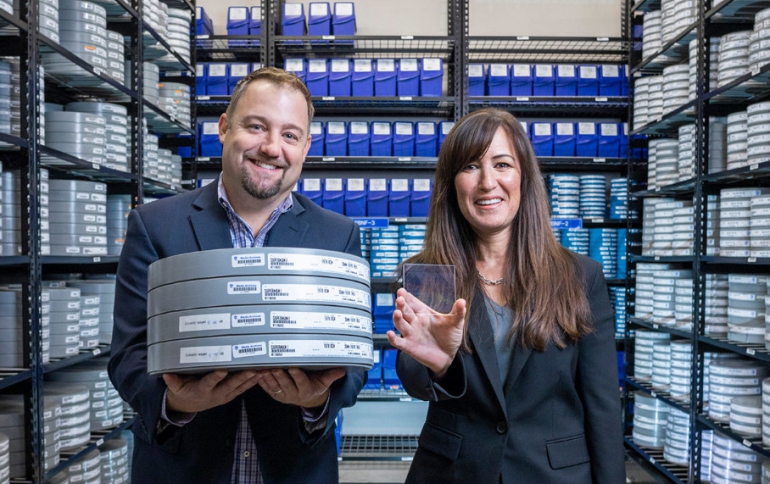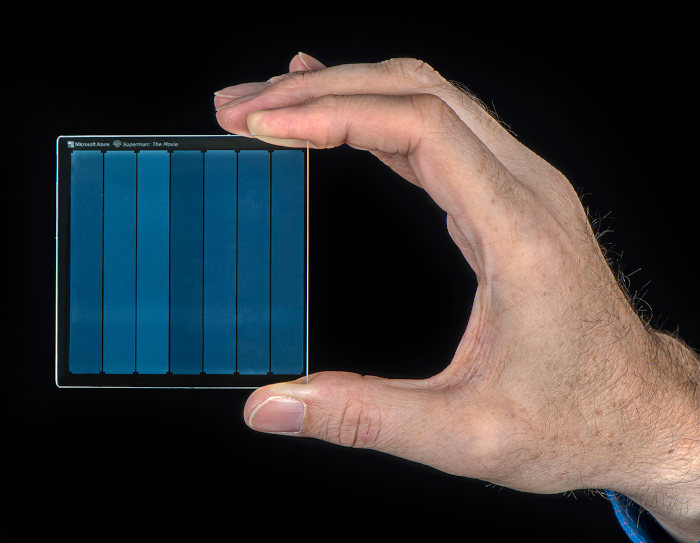
Project Silica Concept Stores Warner Bros. ‘Superman’ Movie on Glass
Microsoft and Warner Bros. have collaborated to store and retrieve the entire 1978 “Superman” movie on a piece of glass roughly the size of a drink coaster, 75 by 75 by 2 millimeters thick.
It was the first proof of concept test for Project Silica, a Microsoft Research project that uses recent discoveries in ultrafast laser optics and artificial intelligence to store data in quartz glass. A laser encodes data in glass by creating layers of three-dimensional nanoscale gratings and deformations at various depths and angles. Machine learning algorithms read the data back by decoding images and patterns that are created as polarized light shines through the glass.
The hard silica glass can withstand being boiled in hot water, baked in an oven, microwaved, flooded, scoured, demagnetized and other environmental threats that can destroy priceless historic archives or cultural treasures if things go wrong.
“Storing the whole ‘Superman’ movie in glass and being able to read it out successfully is a major milestone,” said Mark Russinovich, Azure’s chief technology officer. “I’m not saying all of the questions have been fully answered, but it looks like we’re now in a phase where we’re working on refinement and experimentation, rather asking the question ‘can we do it?’”

Glass storage has the potential to become a lower-cost option for long-term storage because you only write the data onto the glass once. Femtosecond lasers — ones that emit ultrashort optical pulses and that are commonly used in LASIK surgery — permanently change the structure of the glass, so the data can be preserved for centuries.
Quartz glass also doesn’t need energy-intensive air conditioning to keep material at a constant temperature or systems that remove moisture from the air – both of which could lower the environmental footprint of large-scale data storage.
Warner Bros. is potentially looking at Project Silica to create a permanent physical asset to store important digital content and provide durable backup copies.
One goal of Microsoft’s next generation storage research, which includes parallel efforts to store data in DNA, is to develop solutions that are cheap enough and effortless enough that you don’t really have to make a choice about whether to store your data, the company says.
Microsoft researchers spent years trying to get there with technologies currently used in data centers. But the size, shape and constraints of things like spooling tape and spinning disks — all of which were invented for other purposes long before the cloud existed — simply couldn’t get them the gains they wanted.
They launched a collaboration with the University of Southampton Optoelectronic Research Centre, where researchers originally demonstrated how to store data in glass with femtosecond lasers. With investment from Azure, Microsoft’s Cambridge, UK, lab built an interdisciplinary team of physicists, optics experts, electrical engineers and researchers with storage backgrounds to push the technology further.
Since then, the Microsoft Research team has achieved dramatic advances in speed and precision. They’ve also worked closely with their Azure counterparts to design Project Silica with the day-to-day challenges and requirements of commercial cloud storage in mind.
Project Silica’s infrared lasers encode data in “voxels,” the three-dimensional equivalent of the pixels that make up a flat image. Unlike other optical storage media that write data on the surface of something, Project Silica stores data within the glass itself. A 2-mm-thick piece of glass, for instance, can contain more than 100 layers of voxels.
Data is encoded in each voxel by changing the strength and orientation of intense laser pulses that physically deform the glass. It’s somewhat like creating upside down icebergs at a nanoscale level, with different depths and sizes and grooves that make them unique.
To read the data back, machine learning algorithms decode the patterns created when polarized light shines through the glass. Unlike tape storage – which takes time to spool to get to the place you want to read back – the algorithms can quickly zero in on any point within the glass square, potentially reducing lag time to retrieve information.
“If you’re old enough to remember rewinding and forwarding songs on cassette tapes, it can take a while to get to the part you want,” said Richard Black, Microsoft principal research software engineer. “By contrast, it’s very rapid to read back from glass because you can move simultaneously within the x or y or z axis.”
Unlike fragile wine glasses or light bulbs, the squares of quartz glass used for data storage are surprisingly hard to destroy. Early on, the research team tried baking one in an oven at 500 degrees, microwaving, boiling it, scouring it with steel wool. And when they read the data back, it was all still there.
That made total sense to the Warner Bros. archivists, who years ago discovered boxes of Superman radio serials recorded in the 1940s on record-sized pieces of glass.
“We actually found players that we could play these things back on, and they were just as good because they were stored on glass. And we were able to digitize and save those wonderful pieces of content,” Collar said.
“So now one of our oldest assets in our vault is glass and one of the newest technologies in our vault is glass. And they’re both Superman. So we really have come full circle,” he said.





















